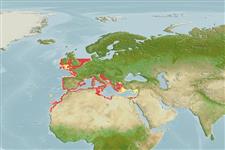Common names from other countries
Classification / Names / Names
आम नाम | उपशब्द | Catalog of Fishes (gen., sp.) | ITIS | CoL | WoRMS
Environment: milieu / climate zone / depth range / distribution range
पारिस्थितिकी
; गहराई सीमा 0 - 90 m (Ref. 85345). Tropical, preferred 17°C (Ref. 107945); 55°N - 21°N, 17°W - 36°E
Eastern Atlantic and the Mediterranean: from UK Scotland to West Sahara, and east to Lebanon. Subtropical and temperate.
Length at first maturity / आकार / वज़न / Age
Maturity: Lm ? range ? - ? cm Max length : 6.0 cm WD पुल्लिंग / अलिंग; (Ref. )
Feeds on marine plants and animal material (Ref. 113042).
Life cycle and mating behavior
परिपक्व अवधि | पुनरुत्पत्ति | मछलीऔ का अंडे देना | अंडे | Fecundity | लार्वा
Members of the class Echinoidea are gonochoric. Fertilization is external. Brooding is common, eggs are held either on the peristome, around the periproct or deep into the concavities on the petaloids. Life cycle: Embryos develop into planktotrophic larvae (echinoplateus) and live for several months before they sink to the bottom using their tube feet to adhere on the ground where they metamorphose into young urchins.
Koukouras, A. and M.-S. Kitsos. 2010. (Ref. 85345)
IUCN Red List Status (Ref. 130435)
CITES status (Ref. 108899)
Not Evaluated
Not Evaluated
Human uses
मात्स्यिकी: व्यापारिक
FAO - जलीयकृषि: production; मात्स्यिकी: landings | FishSource | Sea Around Us
साधन
अधिक जानकारी
Age/Size
बाढ़
Length-weight
Length-length
आकृति विज्ञान
लार्वा
बहुतायत
इंटरनेट स्रोत
Estimates based on models
Preferred temperature
(Ref.
115969): 7.4 - 20.1, mean 11.8 (based on 600 cells).
